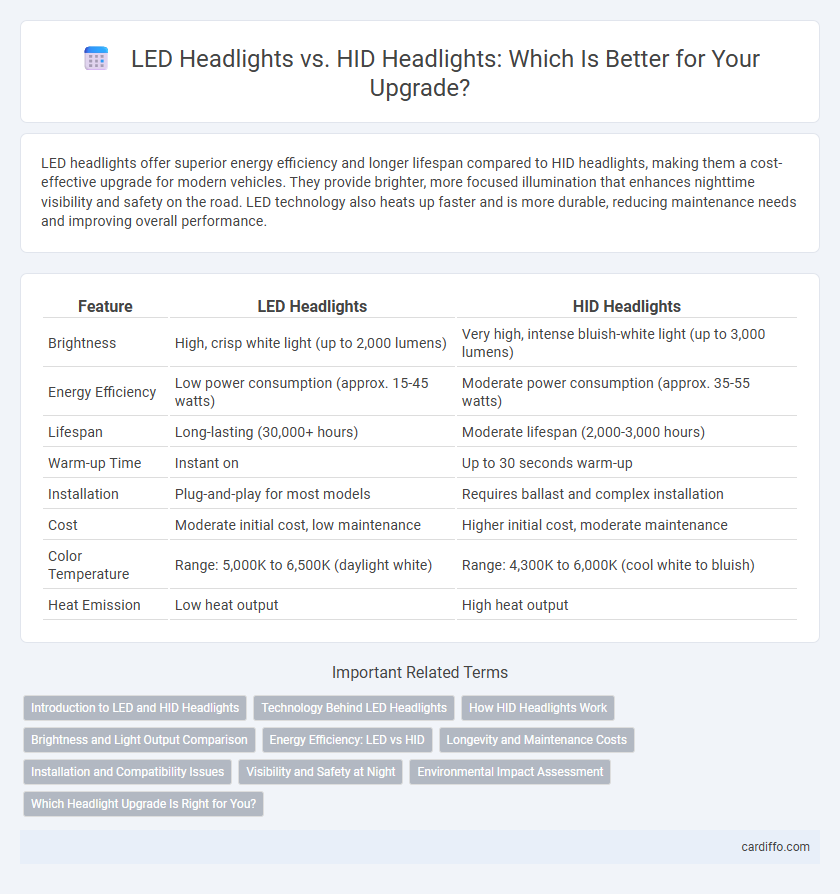LED headlights offer superior energy efficiency and longer lifespan compared to HID headlights, making them a cost-effective upgrade for modern vehicles. They provide brighter, more focused illumination that enhances nighttime visibility and safety on the road. LED technology also heats up faster and is more durable, reducing maintenance needs and improving overall performance.
Table of Comparison
| Feature | LED Headlights | HID Headlights |
|---|---|---|
| Brightness | High, crisp white light (up to 2,000 lumens) | Very high, intense bluish-white light (up to 3,000 lumens) |
| Energy Efficiency | Low power consumption (approx. 15-45 watts) | Moderate power consumption (approx. 35-55 watts) |
| Lifespan | Long-lasting (30,000+ hours) | Moderate lifespan (2,000-3,000 hours) |
| Warm-up Time | Instant on | Up to 30 seconds warm-up |
| Installation | Plug-and-play for most models | Requires ballast and complex installation |
| Cost | Moderate initial cost, low maintenance | Higher initial cost, moderate maintenance |
| Color Temperature | Range: 5,000K to 6,500K (daylight white) | Range: 4,300K to 6,000K (cool white to bluish) |
| Heat Emission | Low heat output | High heat output |
Introduction to LED and HID Headlights
LED headlights offer energy-efficient illumination with longer lifespan and quicker activation than HID headlights. HID headlights deliver brighter, more intense light by igniting xenon gas, providing superior visibility on dark roads. Both technologies improve automotive lighting but differ in power consumption, light quality, and operational speed.
Technology Behind LED Headlights
LED headlights utilize semiconductor technology to produce light through electroluminescence, offering higher energy efficiency and longer lifespan compared to HID headlights, which rely on gas discharge lamps. The compact design of LED modules allows for advanced heat dissipation systems, enhancing durability and performance under varying conditions. This technological advancement provides brighter, more focused illumination with faster response times, improving overall driving safety and vehicle energy management.
How HID Headlights Work
HID headlights generate light by creating an electric arc between two tungsten electrodes within a xenon gas-filled bulb, producing a bright, intense beam with a high color temperature. This arc excites the xenon gas, causing it to emit a nearly daylight-like light that enhances visibility and reduces eye strain during night driving. HID lights generally consume less power and last longer than traditional halogen bulbs, making them a popular upgrade for improved headlight performance.
Brightness and Light Output Comparison
LED headlights produce a brighter and more focused light beam compared to HID headlights, enhancing visibility and road safety. The lumen output of LED headlights typically ranges from 3,000 to 4,000 lumens, surpassing the 2,800 to 3,500 lumens commonly generated by HID systems. LEDs also offer better light distribution and color temperature, resulting in clearer, whiter light that improves contrast and reduces eye strain during nighttime driving.
Energy Efficiency: LED vs HID
LED headlights consume significantly less power than HID headlights, offering enhanced energy efficiency and reduced battery drain for vehicles. They convert a higher percentage of electricity into light, resulting in lower heat output and longer lifespan compared to HID bulbs. This efficiency translates to improved fuel economy and decreased emissions, making LEDs a sustainable choice for automotive lighting upgrades.
Longevity and Maintenance Costs
LED headlights offer significantly longer lifespan, often exceeding 30,000 hours, reducing replacement frequency compared to HID headlights, which last around 2,000 to 3,000 hours. Maintenance costs for LED headlights are generally lower due to their durability, energy efficiency, and fewer required parts, while HID headlights may incur higher expenses from gas refills and ballast replacements. Choosing LED technology ensures enhanced longevity and minimized upkeep, optimizing long-term vehicle lighting investment.
Installation and Compatibility Issues
LED headlights often require minimal modifications for installation in modern vehicles due to their compact design and compatible voltage requirements, whereas HID headlights may need additional components such as ballasts and wiring harnesses. Compatibility issues with HID systems are common in cars not originally equipped with them, potentially causing flickering or error messages on the dashboard. LED headlights generally provide a plug-and-play solution, reducing installation time and compatibility risks compared to HID setups.
Visibility and Safety at Night
LED headlights offer superior brightness and a more focused beam pattern compared to HID headlights, enhancing visibility on dark roads and reducing glare for oncoming traffic. Their instant illumination and consistent light output improve reaction times, increasing overall safety during nighttime driving. Advanced color temperature in LED headlights mimics natural daylight, reducing eye strain and better revealing road hazards.
Environmental Impact Assessment
LED headlights consume significantly less energy than HID headlights, resulting in lower carbon emissions over their lifecycle. The manufacturing process for LEDs involves fewer hazardous materials compared to HID bulbs, reducing environmental pollution during production and disposal. LEDs also have a longer lifespan, decreasing waste generation and the frequency of replacements needed.
Which Headlight Upgrade Is Right for You?
LED headlights offer energy-efficient, brighter illumination with longer lifespan and lower maintenance, making them ideal for daily drivers seeking improved visibility and cost savings. HID headlights deliver intense, high-quality light with superior range and color accuracy, perfect for night driving and off-road enthusiasts requiring maximum road clarity. Choosing between LED and HID depends on your driving conditions, budget, and preference for light intensity versus energy efficiency.
LED headlights vs HID headlights Infographic

 cardiffo.com
cardiffo.com